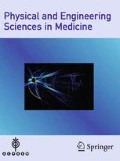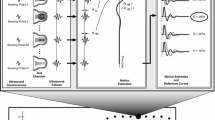Abstract
With the increasing demand for coagulation POCT for patients in the surgery department or the ICU, rapid coagulation testing techniques and methods have drawn widespread attention from scholars and businessmen. This paper proposes the use of electromagnetic induction sensor probe for detection of dynamic process causing changes in the blood viscosity and density before and after coagulation based on the damped vibration principle, in order to evaluate the coagulation status. Utilizing the dynamic principle, the differential equation of vibration system comprising elastic support and electromagnetic induction device is established through sensor dynamic modeling. The structural parameters of elastic support are optimized, and the circular sheet spring is designed. Furthermore, harmonic response analysis and vibration fatigue coupling analysis are performed on the elastic support of the sensor by considering the natural frequency of the system, and the electromagnetic induction sensor testing device is set up. Using the device and coagulation reagent, the standard curve for coagulation POCT is plotted, and the blood sample application in clinical patients is established, which are methodologically compared with the imported POCT coagulation analyzer. The results show that the sensor designed in this paper has a first-order natural frequency of 11.368 Hz, which can withstand 5.295 × 102 million times of compressions and rebounds. Its correlation with the results of SONOCLOT analyzer reaches 0.996, and the reproducibility 0.002. The electromagnetic induction coagulation testing sensor designed has good elasticity and anti-fatigue, which can meet the accuracy requirement of clinical detection. This study provides the core technology for developing the electromagnetic induction POCT instrument for dynamic testing of coagulation process.













Similar content being viewed by others
References
Wang B, Li RZ, Geng WB, Li H (2016) Establishment and verification of rapid detection method for protein content of human coagulation/anticoagulant factor. Chin J Biol 29(4):429–437
Zhou YK (2008) Study on hemagglutination test method based on liquid electric resonance principle. Chongqing Institute of Technology, Chongqing
Oberfrank S, Drechsel H, Sinn S, Northoff H, Gehring FK (2016) Utilisation of quartz crystal microbalance sensors with dissipation (QCM-D) for a Clauss fibrinogen assay in comparison with common coagulation reference methods. Sensors 16(3):282
Lakshmanan RS, Efremov V, Cullen SM, Killard AJ (2014) Measurement of the evolution of rigid and viscoelastic mass contributions from fibrin network formation during plasma coagulation using quartz crystal microbalance. Sens Actuators B 192(3):23–28
Lin YC, Yen SC, Cheng S, Huang T (2014) Effectiveness of holographic optical element module sensor in measuring blood prothrombintime. Meas Sci Technol 25(7):075701
Xu WC, Appel J, Chae J (2012) Real-time monitoring of whole blood coagulation using a microfabricated contour-mode film bulk acoustic resonator. J Microelectromech Syst 21(2):302–307
Zhang ZL, Chen YP, Tao CH, Liu XH, Li MY, Zhou X (2016) Establishment of reference intervals and transfusion criterion for Sonoclot analysis. J Huazhong Univ Sci Technol-Med Sci 36(4):614–617
Zhao M (2006) Study on frequency dynamic response of piezoelectric sensors in prothrombin time and development of piezoelectric coagulation sensor detection system. Third Military Medical University, Chongqing
Grimes CA, Roy SC, Rani SJ, Cai QY (2011) Theory, instrumentation and applications of magnetoelastic resonance sensors: a review. Sensors 11(3):2809–2844
David EW, Fujikawa K (1975) Basic mechanism in blood coagulation. Annu Rev Biochem 44:799–829
Zhao M, Fu WL, Chen M, Luo Y et al (2006) Study on dynamic response of piezoelectric frequency in coagulation reaction. Chin J Nosocomiol 16(11):1229–1232
Sun NN (2012) Research on prothrombin time detection system based on the QCM sensor. Harbin Institute of Technology, Harbin
Ji Y, Meng QH, Wang ZG (2013) Changes in the coagulation and fibrinolytic system of patients with subarachnoid hemorrhage. Neurol Med Chir 54(6):457–464
Zeng P, Chen YH, Gao YY et al (2014) Elastic support type piezoelectric bone conduction hearing device. Opt Precis Eng 22(10):2765–2772
Chen YD (2007) Structural vibration analysis. Jilin University Press, Changchun
Zhang YM (2002) Mechanical vibration mechanics. Jilin Science and Technology Press, Changchun
Han QH, Cheng YH, Lu Y, Li T, Lu P (2016) Nonlinear buckling analysis of shallow arches with elastic horizontal supports. Thin-Walled Struct 109:88–102
Mizuno M, Okayasu M, Odagiri N (2010) Damage evaluation of piezoelectric ceramics from the variation of the elasticity coefficient under static compressive stress. Int J Damage Mech 19(3):375–390
Papadimitriou C, Fritzen CP, Kraemer P, Ntotsios E (2010) Fatigue predictions in entire body of metallic structures from a limited number of vibration sensors using Kalman filtering. Struct Control Health Monit 18(5):554–573
Ma H, Wang JB (2009) Instrument accuracy theory. Beijing University of Aeronautics and Astronautics Press, Beijing
Funding
This study was funded by the Natural Science Foundation of Jilin Province (Grant Number 20140309013YY).
Author information
Authors and Affiliations
Corresponding author
Ethics declarations
Conflict of interest
All authors declare that they have no conflict of interest.
Ethical approval
This article does not contain any studies with human participants or animals performed by any of the authors.
Informed consent
Informed consent was obtained from all individual participants included in the study.
Rights and permissions
About this article
Cite this article
Wang, Z., Yu, Y., Yu, Z. et al. Electromagnetic induction sensor for dynamic testing of coagulation process. Australas Phys Eng Sci Med 41, 105–115 (2018). https://doi.org/10.1007/s13246-018-0618-y
Received:
Accepted:
Published:
Issue Date:
DOI: https://doi.org/10.1007/s13246-018-0618-y




